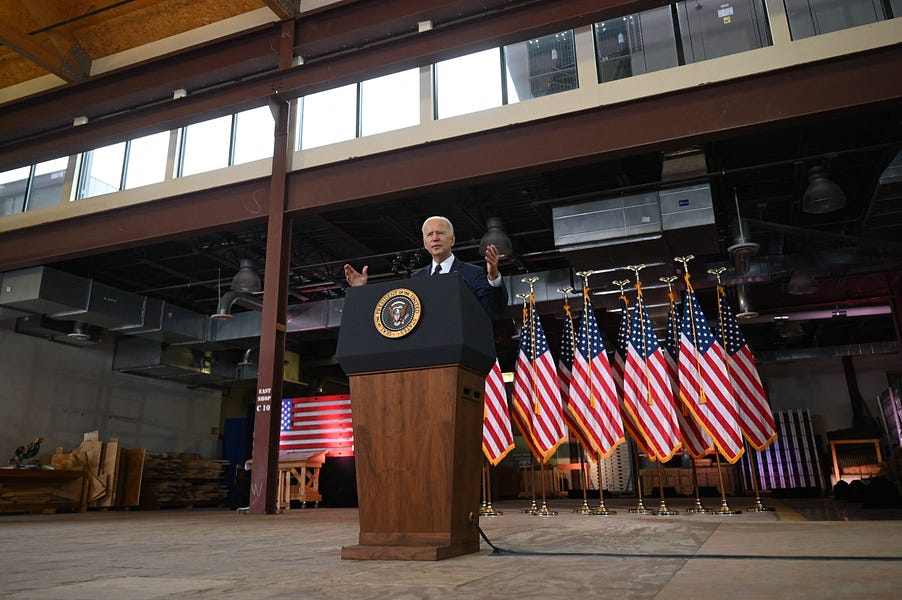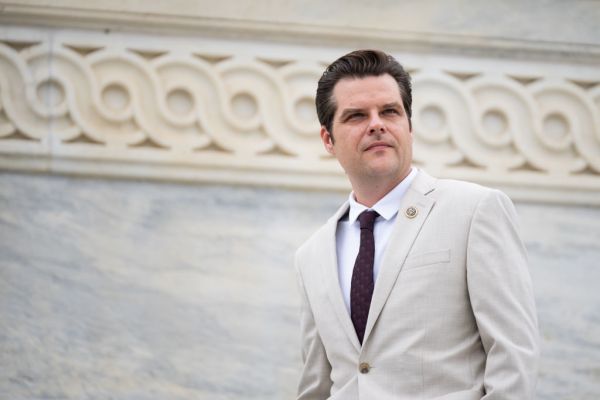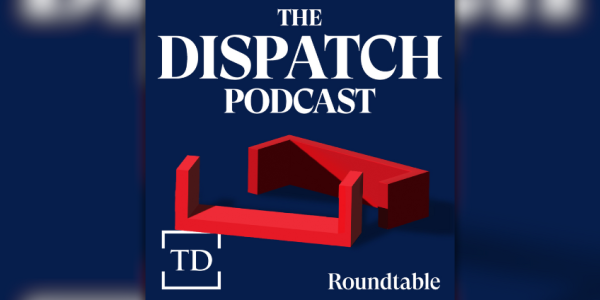President Biden has unveiled a $2.2 trillion grab bag of liberal spending projects creatively branded as an “infrastructure” initiative. The words “invest” and “investment” may appear 160 times in the American Jobs Plan, yet its largest proposal is $400 billion for long-term care for the elderly and disabled, which—whatever its merits—has nothing to do with infrastructure. Same with the proposed billions to support community violence prevention programs, a $10 billion “Civilian Climate Corps” (duties include “advancing environmental justice”), and a proposal to eviscerate state right-to-work laws. Highways, roads, and bridges would receive just $115 billion, or 5 percent of all spending.
The forthcoming release of the “human infrastructure” portion of the proposal is expected to push the total price tag as high as $4 trillion—combining with the pandemic bills to total nearly $10 trillion in new federal spending enacted in one year. And Biden has still promised at least $4 trillion more in new spending in areas such as health care and Social Security.
There is no plausible—or wise—package of taxes that could finance all this new spending. Still, Biden proposes $1.5 trillion in new corporate taxes that dwarf the $300 billion in net corporate tax cuts (over 10 years) enacted in the 2017 Tax Cuts and Jobs Act. That law reduced the corporate tax rate from 35 percent to 21 percent, but offset most of those savings by curtailing key business tax preferences. The president would raise the corporate rate back to 28 percent—restoring America to the highest rate in the OECD—without giving back the tax deductions. Moreover, the president would severely weaken the 2017 tax reforms that finally gave U.S. multinational corporations a level playing field when competing internationally. Now, once again, American companies abroad may face higher tax rates than our global competitors.
Even fully paying for this legislation would not make it fiscally responsible. Using nearly the entire universe of plausible corporate tax increases to finance this initiative leaves few options to pay for the remaining Biden agenda, or deal with the underlying $16 trillion baseline deficit during the next decade. Taxing wealthy families would raise much less revenue than advocates wish to believe, and after that we’re left taxing the middle class to close the surging red ink.
Our infrastructure can certainly use some upgrades, particularly its roads and electrical grid. Yet America’s main infrastructure challenge is not spending levels, but rather its status among the most expensive, bureaucratic, and slowly built in the world. Labor costs are higher in part because the Davis-Bacon Act, which mandates that those awarded government contracts pay a “prevailing wage,” raises wage costs by as much as 22 percent, and America requires many more workers to do the same building work as Europe. Coordination between various local governments and stakeholders—while often necessary—brings endless delays and veto points, particularly for transportation projects. Environmental reviews commonly exceed 1,000 pages and require seven years to complete (compared to no more than one to two years in Canada and 3.5 years in the European Union). Citing one particularly egregious example, Megan McArdle notes that “The Southeastern High Speed Rail Corridor was proposed in 1992. You will be thrilled to learn that in September 2017, the Department of Transportation announced the completion of the project’s Tier II Draft Environmental Impact Statement.”
Biden’s physical infrastructure component simply throws $1 trillion at this broken system. In fact, it would raise costs further by tightening higher-wage requirements and imposing stricter “Buy America” requirements that limit trade and lower-cost options. And it allocates more funding to transit and high-speed rail ($165 billion) than highways, roads, and bridges ($115 billion) despite the surging costs and declining public interest in the former.
A more effective infrastructure initiative would not require such extreme federal micromanagement—or as much new funding. State and local governments are sitting on $350 billion in recent stimulus grants to close budget deficits that in many states no longer exist. Infrastructure investment would be a perfect use of this one-time cash infusion. Additionally, Biden’s call for $100 billion in public school building upgrades and construction is not necessary when states are flush with $180 billion in K-12 capital grants from earlier stimulus bills. The $213 billion proposal to build, rehabilitate, and retrofit millions of homes is expensive, vaguely defined, and runs roughshod over governors and mayors.
Yet only half of this proposal is truly about infrastructure. The largest single proposal—as stated above—is $400 billion for long-term care for the elderly and disabled. The rest of the American Jobs Plan largely consists of one of the largest corporate welfare proposals in history.
Specifically, the Biden administration is trying to position itself as the center of scientific innovation. Instead of merely encouraging research, development, and commercialization by providing tax incentives for investment and R&D, and tightening intellectual property and patent laws, Washington would micromanage the innovation process by steeply raising corporate tax rates, and then returning hundreds of billions of dollars in federal grants to companies that undertake government-approved projects. Advocates point to past federal loans to Tesla that were fully repaid by the flourishing company. However, today’s promising companies have no problem securing loans and equity from a financial system awash in capital and low interest rates.
The administration’s almost limitless discretion in dispensing hundreds of billions of dollars risks becoming a budget-busting slush fund for favored industries, businesses, and allies. The electric vehicle industry would receive $174 billion. Broadband subsidies would total $100 billion, even as the broadband industry already invests more than $50 billion annually in infrastructure. There is a $25 billion “ambitious projects” fund in transportation, $52 billion domestic manufacturing fund, $31 billion venture capital fund, $27 billion “Clean Energy and Sustainability Accelerator,” $14 billion commerce competitiveness fund, $35 billion climate innovation fund, and $30 billion “innovation and job creation” fund.
Central planning is labor intensive, and distributing all these grants would require a staggering number of new federal offices, boards, and agencies. The Department of Commerce would create a $50 billion office “dedicated to monitoring domestic industrial capacity and funding investments to support production of critical goods.” Biden would also spend “$20 billion in regional innovation hubs and a Community Revitalization Fund.” A “technology directorate” would coordinate countless new initiatives lavishing money on the computing, communications, energy, and biotech sectors. Another program would “bring together industry, academia, and government to advance technologies and capabilities critical to future competitiveness.”
But when Washington chooses the wrong winners and losers, the taxpayers pay. The last similar corporate welfare push was in the 2009 stimulus. Back then, a Washington Post investigation revealed that President Obama’s energy grant programs were so “infused with politics at every level” that the White House reportedly ignored red flags and expedited approval of a questionable $535 million loan guarantee to the well-connected clean energy company Solyndra. It was later revealed that the company brazenly misled the administration on its application, and its subsequent bankruptcy left taxpayers holding the bag for the loan.
More examples abound. The Advanced Technology Program (ATP) was a longstanding Department of Commerce program intended to provide last-resort corporate financing to bring their newest technologies to the market. Several scathing GAO investigations revealed that ATP eventually became a slush fund for Fortune 500 companies, in which federal grant reviewers lacked expertise in the fields they reviewed, and were easily (and purposely) misled by grant applicants seeking easy federal cash with few strings attached.
Consequently, just one-third of ATP grants successfully brought a product to market despite the technologies supposedly being ready to commercialize. Both parties terminated the ATP in 2005 and as well as its flawed successor program in 2011. And now President Biden would resuscitate and expand the same failed approach, and give them even more money to throw around.
The idea that the Biden administration can successfully pick innovation winners and losers competently and with no political interference reflects the triumph of hope over experience. Yet central planning is popular with those who aspire to do the planning, and with the well-connected industries hoping to cash in on the government spending gold rush.
The White House, Congress, and much of the public seem to believe that budget constraints no longer exist, doubling the national debt is harmless, and corporate taxes can be drastically increased with no cost to workers, families, and the economy. Thus, they see little downside to throwing $1 trillion at an efficient infrastructure system, and showering favored industries with hundreds of billions of dollars in corporate welfare. When middle-class families eventually get the tax bill for these handouts and boondoggles, they may regret having accepted this reckless spending spree.
Brian Riedl is a senior fellow at the Manhattan Institute. Follow him on twitter @Brian_Riedl.





Please note that we at The Dispatch hold ourselves, our work, and our commenters to a higher standard than other places on the internet. We welcome comments that foster genuine debate or discussion—including comments critical of us or our work—but responses that include ad hominem attacks on fellow Dispatch members or are intended to stoke fear and anger may be moderated.
You are currently using a limited time guest pass and do not have access to commenting. Consider subscribing to join the conversation.
With your membership, you only have the ability to comment on The Morning Dispatch articles. Consider upgrading to join the conversation everywhere.